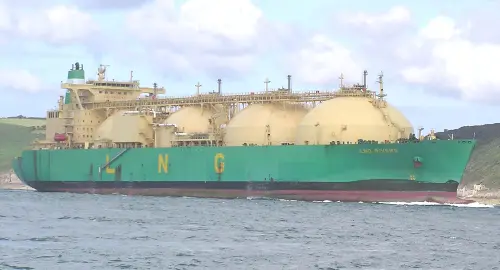Since December 2021, energy prices across the UK and Europe have risen sharply due to a shortage of natural gas supplies.
Europe is reliant upon imports of gas from its giant neighbour Russia. Russia has the world’s most extensive reserves of natural gas and well-developed pipelines to gas directly into the European market.
Russia’s invasion of Ukraine has triggered a series of economic sanctions between the West and Russia that raises uncertainty over the reliability of future supplies. As of June 2022, the Nord Stream 2 pipeline is operating 40% down on usual capacity.
European nations are scrambling to secure alternative gas imports, and liquid natural gas has become crucial. This blog will explore this new way of transporting gas and why it is politically important.
What is liquid natural gas?
Liquid natural gas is simply natural gas that has been cooled down to below minus 162 degrees celsius, where gas turns into liquid.
In its liquid state, natural gas takes up 600x less space than gaseous forms used in pipelines. It’s also safer as a liquid as it is not combustible.
Liquid Natural Gas is used to transport natural gas globally without requiring pipeline infrastructure.
How is liquid natural gas produced?
Natural Gas extraction often occurs in remote locations as a byproduct of drilling for oil. In remote areas building a gas pipeline can be prohibitively expensive. Previously by-product natural gas was just simply burnt off. LNG technology now allows the gas to be exported and sold in the form of liquid natural gas.
To be able to transport natural gas on a boat or by road, it’s necessary to cool the gas to change it into a liquid. This liquefaction process uses giant refrigerators to absorb the heat energy from natural gas.
The gas gradually cools, and when it reaches the negative 162 degrees Celsius, it undergoes a phase change into a liquid.
How is liquid natural gas used?
Liquid natural gas is used to store and transport natural gas. Liquid Natural Gas is cheaply and safely moved globally in giant LNG tankers.
An LNG tanker safely stores liquid gas within large cryogenic tanks. Once an LNG tanker reaches its destination, it will offload the liquid natural gas at a regasification terminal.
A regasification facility turns Liquid Natural Gas back into a gaseous form where it moves across a country using a traditional gas pipeline network. This conventional gas infrastructure moves the gas to either a gas-fired power station to produce electricity or to be used directly by consumers.
An LNG tanker safely stores liquid gas within large cryogenic tanks. Once an LNG tanker reaches its destination, it will offload the liquid natural gas at a regasification terminal.
A regasification facility turns Liquid Natural Gas back into a gaseous form where it moves across a country using a traditional gas pipeline network. This conventional gas infrastructure moves the gas to either a gas-fired power station to produce electricity or to be used directly by consumers.
Who uses liquid natural gas?
Liquid Natural Gas moves from countries that produce excess natural gas to those that need to import.
The world’s biggest producers of liquid natural gas are:
- The USA, where shale gas technology produces a glut of cheap natural gas. The US exports excess gas globally using liquefaction terminals on the Atlantic and Pacific coasts.
- Qatar, is a small state that encompasses 14% of all the world’s natural gas reserves. Qatar exports LNG using liquefaction terminals on the Persian Gulf Coast.
- Australia, is an isolated island with a vast surplus of gas reserves which it sells as liquid natural gas to the Asian market.
The world’s biggest importers of liquid natural gas are:
- Europe, a continent currently starved of its usual supply of natural gas from its neighbour Russia, is fast increasing its LNG regasification terminal capacity to allow more liquid natural gas imports.
- Japan, an isolated island with no natural gas resources, Japan imports its entire gas needs using regasification terminals.
- China, a vast country with a fast-growing economy produces much less gas than it consumes. The import of LNG from the Middle East and Australia is becoming a growing component of China’s energy needs.
What are the benefits of liquid natural gas?
The main benefits of using liquid natural gas are:
- It’s convenient to transport long distances using international shipping.
- It’s easily converted back into a gaseous form to generate electricity.
- It’s the most environmentally friendly fossil fuel, producing 45% less damaging emissions than coal.
- It’s safe to store as it’s not combustible in liquid form.
- There are over 200 years of remaining gas reserves available globally based on current consumption and known gas reserves.
Why is liquid natural gas important to Britain?
Back in the 1990’s Britain enjoyed energy independence where the North Sea Gas Fields produced more gas than the country used.
Despite recent projects such as Jackdaw, North Sea Gas production is declining. The UK needs to import natural gas to meet domestic demand.
To accept liquid natural gas, the UK has developed liquefaction facilities in Milford, South Wales and Kent, allowing the import of gas from LNG tankers. These facilities enable the UK to purchase gas from America and the Middle East without relying on Russia’s exports.
Being able to circumvent the need to purchase gas from Russia is politically significant as it deprives Russia of economic leverage with the ability to starve Britain of gas supplies.
In June 2022, LNG imports increased nearly 50% year on year. The gas currently being supplied to businesses will inevitably include a portion of LNG imports.
Find the best commercial energy deals with AquaSwitch using our business gas comparison service.


